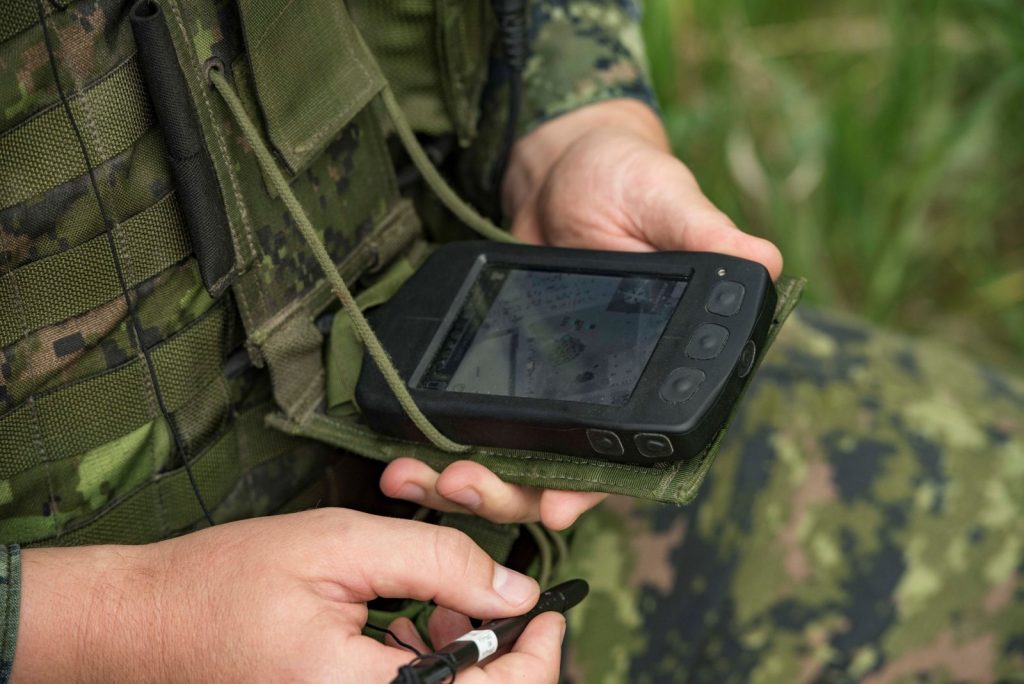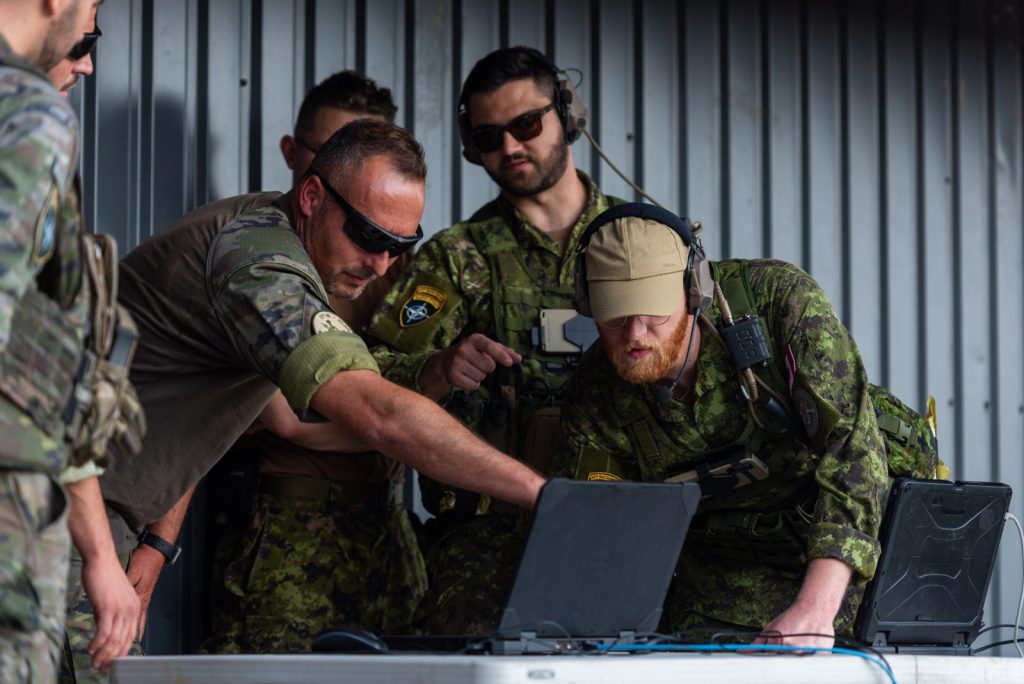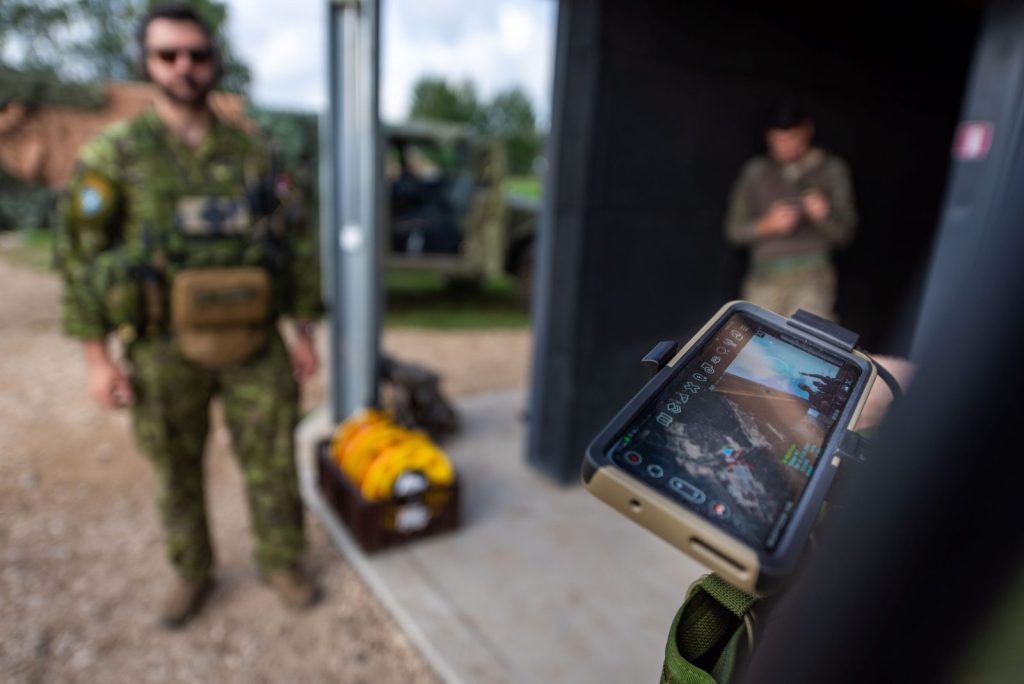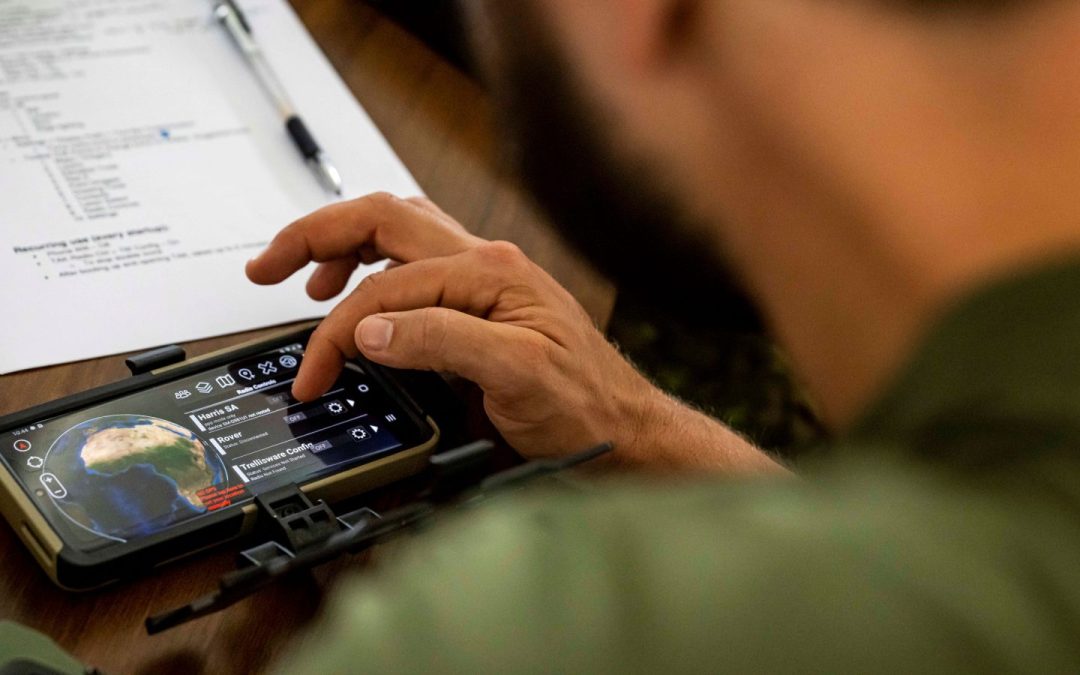by Chris Thatcher
Perhaps it was the communication plan, perhaps the sample size of the user evaluation, but when the Army rolled out the first cycle of a tactical smartphone-like computer system intended to network a platoon-sized formation, only some units embraced it.
“The biggest lesson learned we had with this project was user acceptance,” admitted Frank Mouawad, until recently the project manager for the Integrated Soldier System Project (ISSP) within the Assistant Deputy Minister (Materiel) (ADM Mat) branch.
It wasn’t for lack of effort. From the outset, the project team wanted soldier input on the utility of the Palm Pilot-like devices in operational scenarios. During the bid evaluation, they conducted a user trial in Petawawa, giving soldiers from the 3rd Battalion, Royal Canadian Regiment (3 RCR) samples of each of the systems being considered to test. And that feedback was instrumental in selecting the eventual winner.
But once the preferred system was selected and fielded across the Army, the project team soon discovered acceptance was underwhelming — few units adopted it, and most of those did not fully employ it.
“What we quickly learned was that every brigade operates differently and has different needs. And we had picked only one brigade for the bid [evaluation] trial,” said Mouawad, “so it met the needs of 3 RCR, which is why they used the kit the most.”
Feedback from the other brigades in Edmonton and Valcartier was not positive, he said. “In principle, it did what it was requested to do, but there was a whole optics perspective.”
The Integrated Soldier System Suite (ISS-S) was awarded to Rheinmetall Canada in 2015 and consisted of a tactical display computer, radio, push-to-talk headphone, hub, and battery pack, all connected on a modular fighting rig. Almost 3,000 were fielded in 2019, and the Army intended to keep improving the system in two more cycles, upgrading software as required and integrating more sensors.
Premised on the belief that a picture is worth more than words, the system, known by the company as Argus, gives platoon- or section-level commanders and individual soldiers better situational awareness and faster dissemination of information, by using a digital map with blue force tracking to share critical information.

The first cycle of the integrated tablet during trials in Petawawa in June 2018. Photo: OS Camden Scott
The first cycle was always intended to be a baseline system, improved over time with user feedback. Though it was bulky, the Army was able to confirm the value of the concept and demonstrate its potential.
It was tested on the Infantry Dismounted Company Commander’s Course in the fall of 2018 to favourable reviews, albeit with reservations about battery weight, some of the connectors, and the ability of the network to absorb so much data effectively.
And a Defence Research and Development Canada (DRDC) trial on future soldier technologies, conducted at the same time, found that individual soldiers and small teams were able to complete tasks more quickly with the system than the baseline kit they had used in Afghanistan. The tasks included planning and executing a route while adapting to barriers such as a minefield; searching an operational area for an evading enemy or downed aircrew; mission planning and giving orders; and executing a mission from multiple insertion points.
“Anything the sections did (with the ISS-S took) a fraction of the time it took without ISS-S,” Linda Bossi, the lead defence scientist, noted at the time.
The phased approach, however, may have been undersold to the receiving units. A more robust communication campaign explaining the intent of the initial fielding might have helped soldiers understand their role in the project, Director Soldier Systems Program Management admitted.
While the turnkey system met the Army’s specific requirements, it did not offer much flexibility to make major adjustments. With the second and third cycles still being fully defined – and starting to overlap – and with the limited uptake by most Army units, the ISSP team went back to the drawing board and asked, “how can we get the best system for the Army, but in the most flexible and agile manner,” said Mouawad.
“We started looking at how we could adopt agile project management and how we could get outside of the box and get creative,” he said. “This was one of the rare projects where we [had] a chance to do a midlife upgrade [early] in the project because the technology [was] evolving so quickly.”
After exploring what the U.S. Army and NATO partners were doing, especially with commercial-off-the-shelf mobile devices, there was little doubt in the logic of adopting a cellphone with millions of dollars of commercial investment behind it.
“Why try and reinvent the wheel,” he admitted. “The phones meet 90 percent of the Army’s requirement … and [we] will be in line with the rest of the world.”

Members of the Spanish and Canadian Armed Forces work together on the integration of the Integrated Soldier System Generation 2 communications equipment during Operation Reassurance in Latvia in August 2023. Photo: Capt Joffray Provencher
In addition to commercial phones, it also became apparent that the U.S. Army and others, including other projects in the Canadian Army such as Digitally-Aided Close Air Support (DACAS), were employing Android Tactical Assault Kit (ATAK) software — a capability that had not been readily available or as widespread when ISSP began.
Developed by the U.S. Air Force Research Laboratory in 2010 and adopted initially by U.S. Special Operations Forces, ATAK commercial (known as Android Team Awareness Kit-CIV) and military software has rapidly become the baseline for shared real-time situational awareness among para-public and military operators, with detailed mapping, blue force tracking, and encrypted data communication by text, voice and video.
Significantly, it readily integrates approved plug-ins. Most companies with military devices such as night vision systems, laser range finders, drones or even call-for-fires applications, are building plug-ins for ATAK.
After acquiring Samsung S-20 phones and ATAK through a foreign military sales agreement with the U.S., the ISSP team then competed for a hub and cables to connect with the current battery on the existing tactical vest.
“It is almost a carbon copy of what the U.S. has and what NATO has been following through with,” said Mouawad, but it is “tuned and designed for Canada.
“Rheinmetall still does software development, but other than the plug-ins that are designed for ATAK, there is no more intellectual property. We don’t have to go back to one vendor to replace portions of it. We are now fully agile and fully interoperable.”
More importantly given user feedback to the first iteration, the S-20 and apps are familiar territory to soldiers who rely on their cellphones in their personal lives.
“ATAK looks like Google Maps, except it’s on steroids,” he said. “The system that we’re fielding is a SOFCOM system. We’re the first country that is deploying a system like this, to dismounted soldiers that are not special forces. The soldiers know they are getting something relevant, something that is cutting edge. So, you’ve broken down a lot of barriers.”
The updated ISSP has been distributed in small quantities to all three of the Canadian Mechanized Brigade Groups and the project team anticipates launching a training program over the coming winter, in early 2024.
“They’re finishing up the training package at the moment,” said Mouawad, who transferred this summer to the Joint Fires Modernization project as its associate program manager. “All the units have small quantities, and they’re going on exercises with them.”
The system was tested on Exercise Maple Resolve in May with some success — the project team was congratulated by Army Commander LGen Joe Paul — and over 200 sets were sent over the summer to the battle group in Latvia for evaluation in exercises.
“We were still in a trial basis, so we used Maple Resolve to learn,” said Mouawad. “We have different variants of the kit. In the past, we had one system. Now we have a commander variant and an assaulter variant, though that name might change. We developed the kit in a flexible manner that is more ergonomic. The commander, which will carry more sensors and gear, will have a different hub that is much larger. The assaulter will get a much more streamlined, lighter hub.”
The encouraging feedback has already resulted in a 2.0 version of the system this summer, and the team is now working on 3.0, which could include an upgrade on the Samsung S-20 phones and a more malleable battery. “It would still be a lithium-ion battery,” he said, “but a conformal, wearable one – we’re migrating towards safer and more ergonomic batteries.”

Photo: Capt Joffray Provencher
There remain some networking challenges to overcome. As part of their trials, the brigades are focused primarily on integration with the current Land Command Support System architecture as the Army develops a new digital backbone.
“When you’re integrating it into the rest of the architecture, and the rest of the architecture is still getting figured out, that’s where the challenges are,” observed Mouawad. The brigade units have “proven that they can plug in any component they want. They have bought tethered drones … and a bunch of other components to play around with, but their focus right now is really the network.”
The system also must bridge the unclassified-classified divide. DACAS, for example, operates on a classified network to communicate with aircraft; ISSP is on an encrypted unclassified network due to the volume of users and the nature of the information being shared. Ideally, though, Joint Terminal Attack Controllers and dismounted soldiers could easily share data on the same display system.
ISSP could also be an early example of how ADM (Mat)’s Continuous Capability Sustainment (CCS) initiative functions. The project team has advanced a rolling wave approach that would see systems acquired and delivered to Army units just before they begin their high readiness training cycle. “We got consulted on (CCS) quite heavily,” said Mouawad.
Using current supply arrangements and a just-in-time distribution model, soldiers would have “a roadmap for replacing devices that rapidly go obsolete.” And with the ATAK community continuing to grow, there would be no shortage of downloadable applications for Army employment. “That’s the ideal, that you time everything to provide the soldier with the latest whenever they’re starting up their training.”
Mouawad spent 10 years working in the Royal Canadian Air Force simulation group, much of it on implementing the Canadian Advanced Synthetic Environment (CASE), a joint distributed mission training network. Like CASE, ISSP has found traction with some creative thinking.
“I think the biggest thing for ISSP was getting outside of the box, being more agile, looking at different methodologies that would be more current, more modern than the typical template projects are told to follow,” he said. “And you can see that the Army’s benefiting.”

